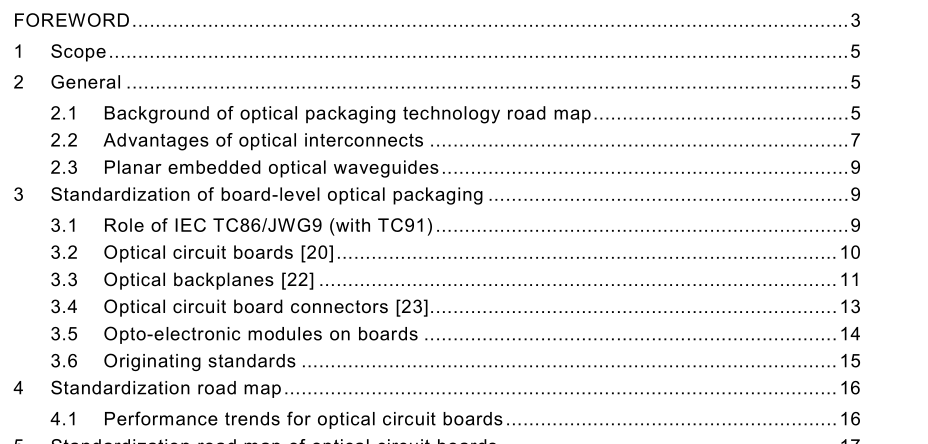IEC TR 62658-2013 pdf Roadmap of optical circuit boards and their related packaging technologies

2.3 Planar embedded optical waveguides It is proposed that the resulting performance bottleneck due to the electrical constraints described above be substantially reduced by conveying high-speed data optically instead of electronically. This requires that optical channels be incorporated into the system at the printed circuit board (PCB) level. While many technology solutions have been put forward and commercially deployed to support embedding conventional optical fibres onto printed circuit boards, there has been a great deal of research and development activity centred in Europe looking at the fabrication and deployment of planar optical waveguide channels on/ in printed circuit board substrates[1 0] to [1 8]. The key academic contributors to research into planar optical waveguides include University of Cambridge, University College London, Vrije Universitaet Brussels, University of Ghent, Loughborough University, Heriot-Watt University and Fraunhofer Institute IZM, while the key industrial contributors include IBM Research in Zürich, Xyratex Technology, TTM Technologies, Vario-optics, TE Connectivity, FCI and Dow Corning. Collectively research and development activities in this field have included a wide range of planar waveguide fabrication techniques, in-plane and out-of-plane waveguide coupling and connector solutions. Though this activity has been mostly centred on polymer waveguides, some research and development has been carried out on embedded planar glass waveguides as well. 3 Standardization of board-level optical packaging 3.1 Role of IEC TC86/JWG9 (with TC91 ) Broadband technologies and services using optical networking systems have come into widespread use, not only at the backbone level but also at the access level. As data bandwidths continue to increase, the optical interconnect must be driven even further down, to the system level, which requires the development of suitable opto-electronic packaging and interconnect solutions to accommodate the system environment.
Board mounted optical transceiver modules will increase in both channel count and data rate. In 201 1 , mid-board transceiver modules with 4 duplex or 1 2 single channels operating at 1 0 Gbps per channel were commercially available, with array subcomponents such as 4 and 1 2 channel VCSEL arrays and PIN photodiode arrays operating at up to 25 Gbps and single channel components operating at 40 Gbps available from certain vendors to enable 4 duplex channel 40 Gbps midboard transceivers and beyond. According to the board capacity trends shown, current 1 0 Gbps array technologies would typically require 30 optical channels per board, while the introduction of 40 Gbps array technologies in the near future would push this requirement to 1 00 optical channels per board.
- ISO IEC 27050-4-2021 pdf Information technology — Electronic discovery — Part 4: Technical readiness
- ISO IEC 27036-1-2021 pdf Cybersecurity — Supplier relationships — Part 1: Overview and concepts
- ISO IEC 27013-2021 pdf Information security, cybersecurity and privacy protection — Guidance on the integrated implementation of ISO/IEC 27001 and ISO/IEC 20000-1
- ISO IEC 26580-2021 pdf Software and systems engineering — Methods and tools for the feature- based approach to software and systems product line engineering
- ISO IEC 24735-2021 pdf Information technology — Office equipment — Method for measuring digital copying productivity
- ISO IEC 24711-2021 pdf Information technology — Office equipment — Method for the determination of ink cartridge yield for colour inkjet printers and multi- function devices that contain printer components
- ISO IEC 23544-2021 pdf Information Technology — Data centres — Application Platform Energy Effectiveness (APEE)
- ISO IEC 23510-2021 pdf Information technology — 3D printing and scanning — Framework for an Additive Manufacturing Service Platform (AMSP)
- ISO IEC 23127-1-2021 pdf Information technology — Learning, education, and training — Metadata for facilitators of online learning — Part 1: Framework
- ISO IEC 23126-2021 pdf Information technology for learning, education and training — Ubiquitous learning resource organization and description framework
- IEC 62372-2021 pdf Nuclear instrumentation – Housed scintillators – Test methods of light output and intrinsic resolution
- IEC TS 62966-3-2021 pdf Mechanical structures for electrical and electronic equipment – Aisle containment for it cabinets – Part 3: Aspects of operational and personal safety
- IEC TR 62222-2021 pdf Fire performance of communication cables installed in buildings
- IEC 62845-2015 pdf Railway applications – Radio remote control system of traction vehicles for shunting application
- ISO IEC 23544-2021 pdf Information Technology — Data centres — Application Platform Energy Effectiveness (APEE)
- BS ISO IEC 15420-2009 pdf Information technology一 Automatic identification and data capture techniques EAN/UPC bar code symbology specification
- BS ISO IEC 19762.5-2008 pdf Information technology一 Automatic identification and data capture (AIDC) techniques – Harmonized vocabulary Part 5: Locating systems
- BS IEC 60860-2014 pdf Radiation protection instrumentation一 Warning equipment for criticality accidents
- ISO IEC 24735-2021 pdf Information technology — Office equipment — Method for measuring digital copying productivity
- ISO IEC 24711-2021 pdf Information technology — Office equipment — Method for the determination of ink cartridge yield for colour inkjet printers and multi- function devices that contain printer components